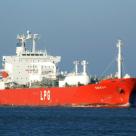Last week we covered what seemed like an onslaught of U.S. ethane export developments – Enterprise’s plans to build an ethane export facility on the Gulf Coast, INEOS’s agreement to take a portion of that facility’s capacity, INEOS’s expansion of its order for more ethane ships, and still more ethane ships ordered by Navigator Gas. What does all of this mean for the U.S. ethane market? Could 240 Mb/d of ethane export capacity due to begin operations in Q3 2016 shift the future of the entire U.S. ethane market? In today’s blog we assess the impact of large scale exports on the market for U.S. ethane.
Daily Energy Blog
U.S. ethane has never been exported overseas. Not yet, that is. Week by week, the details of an emerging export market for U.S.-sourced ethane are coming into focus. Enterprise Product Partners, which has been expressing interest in exporting ethane for some time, a couple of weeks ago announced plans for a 240 Mb/d export terminal on Texas’s Gulf Coast and explained how it sees things shaking out. Navigator Holdings, a major shipping company, has placed an order for new semi-refrigerated liquefied gas carriers capable of carrying ethane (or ethylene). And while U.S. ethylene producers fret about how ethane exports could drive up domestic ethane prices, there is solid evidence ethane will remain a surplus, low-cost commodity for years to come. In this follow-up to our recent ethane exports series, we consider recent developments and what they mean.
Exports of liquefied petroleum gases (LPGs – propane and butane) from the U.S. to international markets - are expected to nearly double from 460 Mb/d in 2014 to 915 Mb/d in 2019 as production from gas plant processing exceeds domestic demand. Available Very Large Gas Carrier (VLGC) vessels to carry these increased overseas volumes are limited. As a result spot freight rates have reached record levels recently. In today’s blog “Stayin’ Afloat With the LPGees – Part 4 Freight Voyage Calculation Model” Sandy Fielden walks through a voyage cost calculation. Today we walk through a voyage cost calculation.
Propane has received a lot of airtime in recent months given the Polar Vortex and heavy crop drying demand anomalies coinciding with growing propane export volumes. Now it’s time to show normal butane a little love as normal butane exports almost tripled from this time last year. In January 2013, 22 Mb/d of butane was exported; that number was 63 Mb/d in January 2014, as reported by the EIA. All indications are that butane export volumes will be experiencing an astronomical growth rate over the next five years, reaching 300 Mb/d by 2019. What are the factors driving this rate of growth, and what are the implications for refiners and petrochemical companies? In today’s blog, we assess the rapid growth in normal butane exports.
All the export LPGs on the West Coast are in a tank in the middle of Washington State in somebody else’s name. So if you’re dreamin’ about LPG exports, the West Coast is a brand new game. Apologies to Larry Gatlin.
On March 4th, Petrogas announced the purchase of the Ferndale, WA LPG terminal, the only functioning butane and propane export facility on the U.S. west coast. Then last Thursday (April 10th) Sage Midstream announced a project to build another world scale LPG (liquefied petroleum gas) export terminal a couple of hundred miles south at the Port of Longview, WA. These are big developments for the west coast LPG markets. Today we begin a blog series that examines the history of Ferndale, how it has been used in the past, and what these two announcements mean for the future of west coast propane and butane markets.
With U.S. ethane prices low and ethane rejection expected to continue increasing, interest in exporting liquid ethane is ramping up. But there are significant barriers to these exports, including: (1) loading and unloading terminal infrastructure, (2) shipping, (3) pricing, and (4) petrochemical demand. We examined the first two of these barriers earlier this week. Today we wrap up this blog series, examining pricing and demand.
Today the US is producing more natural gas, natural gas liquids (NGLs) and some grades of crude oil hydrocarbons than we can use. Consequently we’ve shifted from an overall position of hydrocarbon shortage to one of surplus. But only some of those surplus products can be exported. That’s because of rules put on the books during the decades of shortage that restrict or ban the export of hydrocarbons. At least six such “Molecule Laws” are now variously impacting international market transactions involving US produced hydrocarbons. Today we describe the export rules affecting NGLs.
It is a familiar refrain in the shale era. The U.S. produces more of a hydrocarbon commodity than it can use. This time we are talking ethane, a natural gas liquid that is experiencing production constraints mostly due to the inability of U.S. petrochemical plants to use more of the feedstock. So why not just export the surplus? Unlike crude oil there are no legal constraints on exports. Unlike natural gas, you don’t need a $10 billion plant to convert it to a liquid (LNG) – ethane is already a liquid. Unfortunately for many ethane wannabe exporters, ethane has its own infrastructure and market issues that must be resolved before it can be shipped overseas in significant quantities. Today we continue our blog series on the feasibility of overseas ethane exports.
At our School of Energy International LPG session earlier this month, Kelly Van Hull presented RBN’s outlook for global liquified petroleum gases (LPG) production – showing the US poised to become the world’s top exporter of LPGs within the next year or two - displacing Qatar. While most U.S. LPG exports go to Latin America today, a growing portion will move to Europe and Asia in the future. The limited fleet of very large gas carriers (VLGCs) used to ship LPG is growing rapidly with a record new build order book of 72 ships – 45 percent of today’s fleet of 161 vessels. Spot freight rates assessed daily by London’s Baltic Exchange are also at record levels of $82/MT this week. Today we take a closer look at international LPG ship chartering.
The large and growing surplus of U.S. ethane is leading producers and shippers to step up efforts to export ethane to Europe and eventually to Asia. But there are several hurdles, including the need to construct specialized dock and loading facilities, special ships required to move ethane in overseas trade, unloading and storage facilities at the receiving end, and the need for ethylene crackers in the global market —most of which now use naphtha as their feedstock—to make costly modifications before they can switch to ethane. It may be costly, but it could happen. There are those that hang on to the belief (a mistaken one, we think) that the ethane surplus will disappear later this decade as planned U.S. crackers come online and use increasing amounts of ethane. It is true that those plants will use a lot of ethane. But not nearly enough. Today in the first episode of this blog series we begin to explore the ethane-export issue.
We’ve done several blogs over the past months about the impact of the back-to-back crop drying and Polar Vortex anomalies on natural gas liquids (NGL) prices in general and propane prices in particular. Today we are going to take a walk further downstream and look at how increasing propane exports, the weather related anomalies and subsequent price spikes shifted the petrochemical feedstock slate. From mid-year 2013 to early 2014, huge volumes of propane were backed out of the petrochemical sector, replaced for the most part by ethane. These swings have important implications for the future consumption of NGL feedstocks by petchems. In today’s blog, we assess petrochemical feedstock switching in the 2013-14 timeframe, and beyond.
Exports of liquefied petroleum gases (LPGs) from the U.S. to international markets - are expected to nearly double from 466 Mb/d in 2014 to 825 Mb/d in 2018 as production from gas plant processing exceeds domestic demand. There are two LPG export terminals on the Houston Ship Channel that have been responsible for most exports, another six around the country that have exported some LPG over the past year, and still another four new-builds that have been announced. That’s a lot of volume and a lot of dock capacity. One question is whether there are enough LPG ships to handle all of these exports. Today we introduce our review of this question, looking at the specialized vessels used to ship LPGs.
US waterborne exports of propane, normal butane and isobutane – known collectively as liquefied petroleum gases or LPGs - are growing rapidly – up from 148 Mb/d in 2011 to 316 Mb/d in 2013. RBN expect these volumes to continue growing from 466 Mb/d this year to 825 Mb/d in 2018 as LPG production from gas plant processing increases more rapidly than domestic demand. The two largest export terminals operated by Enterprise and Targa will add 400 Mb/d of capacity between 2013 and 2018 and as many as 8 more terminals could be built. Today we begin a deep dive series into LPG shipping.
The recent propane shortage is being called a “crisis” and for good reason. But like so many “crises” there is more to the story than is generally known and in this case it’s worth a careful examination of the events involved. Clearly it was a perfect storm in the balance of supply and demand, resulting in huge price spikes. And the consequences included panic, headline news, government intervention and of course, lots of finger pointing. Today we look at how the market responded and why the propane industry will once again be stronger for it.
We’ve been talking a lot over the past year about the need for increasing exports to balance the U.S propane market as growth in production from gas processing plants outruns domestic demand. U.S. propane production from gas processing has increased by over 100 Mb/d since January 2013, and there’s lots more to come. For the first time U.S. propane exports exceeded 400 Mb/d in October 2013 thanks to growing U.S supply and infrastructure developments including dock expansions by Enterprise and Targa. But just after exports ramped up, the propane market was hit by a couple of wild cards – a late and very heavy crop drying season and a series of record cold temperature events. In today’s blog, we continue our series covering the record setting 2014 NGL markets.




